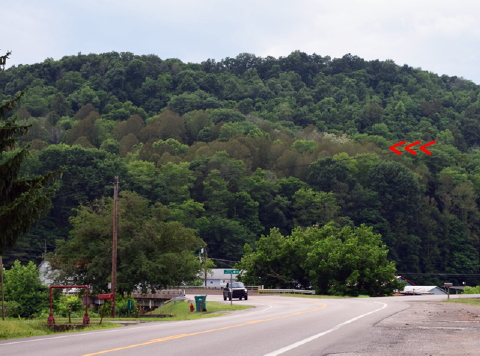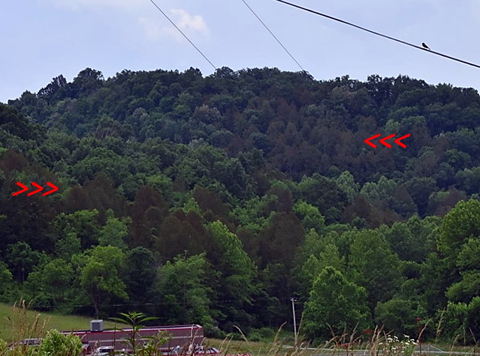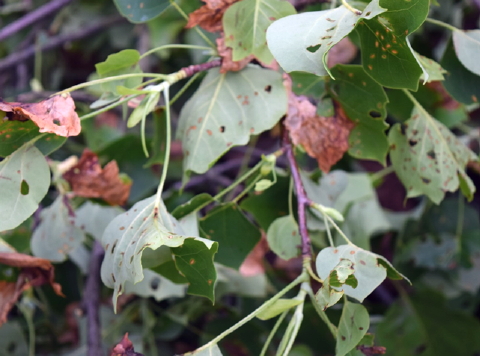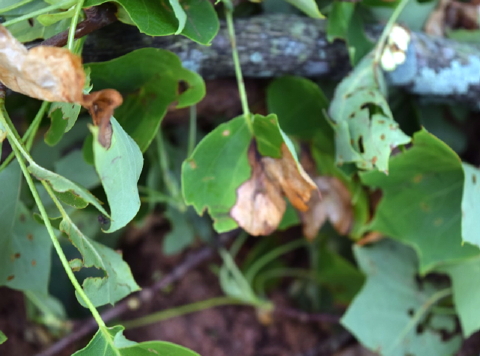| UPDATE - The browning of poplar trees in Calhoun and the regional, first reported on the Hur Herald and written about by forrester Russ Richardson, has been confirmed by the WV Department of Agriculture.
Agriculture officials are saying small black beetles are damaging poplar trees across West Virginia.
Officials said Tuesday that most healthy trees will survive the onslaught by yellow poplar weevils.
They also said trees stressed by drought or other problems can be seriously damaged.
State forester Randy Dye says the Division of Forestry is working the Department of Agriculture to monitor the situation.

Insect damaged yellow poplar trees on
the hillside above the Arnoldsburg VFD
By Russ Richardson, Forester
Yellow poplar weevils are causing damage to the foliage of yellow poplar trees throughout West Virginia in an infestation that has become extremely visible during the past couple weeks. Locally, insect damage to the yellow poplars is now so common that it is difficult not to notice the buff colored trees on nearly every hillside and pasture edge.

It is very easy to spot the yellow poplar on
the hillside above Arnoldsburg Elementary School

Early signs of the poplar weevil infestation
in late May when foliage damage started to show
The last time poplar weevils caused extensive damage to local trees was during the summer of 2012 when any surface beneath poplar trees became coated with a slimy black mold that stuck like glue and made many hard topped roads slick to drive on and exceptionally dangerous to motorcycles.
The slimy black mold was later discovered to be caused by the bodily waste of a second native pest, magnolia scale, that survived the extremely warm 2012 winter that never was in incredible numbers.
It does not appear that magnolia scale is damaging the poplar trees this year.
In 2012 it took a while to figure out what was causing damage to the yellow poplars because the poplar weevils had been very uncommon for almost fifty years (since the 1960s) and no one was working in the forest pest field that had encountered weevils in damaging numbers like we experienced locally.
The typical shotgun pattern that results in leaves full of holes caused by the feeding of adult weevils on the young poplar buds as they open in the spring.
This year the additional browning and dying of poplar leaves observed in many areas is caused by the extremely small yellow poplar weevil larvae "mining" the leaves and destroying them by "mining" or eating the inside middle portion of the leaf.

Damaged yellow poplar leaves
early in the 2015 growing season
Poplar trees are now shedding the most heavily damaged leaves and it is possible that many severely damaged trees may not recover. After the 2012 infestation, yellow poplar trees in portions of Lewis, Braxton and Webster Counties died in great numbers.
It is hoped that 2015 is the peak year for defoliation and damage to poplar foliage but only time will tell. Unlike gypsy moths that leave large egg masses on host trees or forest tent caterpillars that leave egg masses on cherry twigs, there is no practical way to inventory woodland for a potential yellow poplar weevil infestation or outbreak.
To report extreme damage to forest trees or other forest health questions contact the WV Department of Agriculture in Charleston at 304-558-2212.
See earlier story YELLOW POPLAR WEEVILS CAUSING WIDESPREAD DAMAGE - Foliage Of Central West Yellow Poplar Trees
| 


